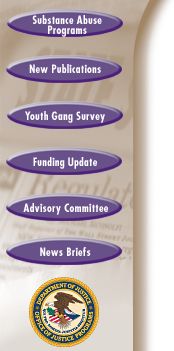
|
|
March/April 2004 Volume III Number 2 |
 |
|||
|
|||

J. Robert Flores
OJJDP Administrator |
|
Combating Youth Substance Abuse: Evidence-Based, Collaborative Strategies
One of the worst decisions our children can make is to gamble their lives and futures on drugs. —President George W. Bush Substance abuse is one of the most troubling problems facing the nation’s youth. Although recent surveys document some encouraging trends, far too many young people still take the dangerous gamble of using drugs. The 2002 National Survey on Drug Use and Health found that almost 31 percent of youth ages 12–17 had used an illicit drug at some point in their lives, 22 percent in the last year, and more than 11 percent in the last month. The survey also found that 37 percent of youth had used tobacco (24 percent last year, 15 percent last month). Alcohol use was even more common: 43 percent (35 percent last year, 18 percent last month). Usage surveys tell only part of the story. Researchers have found associations between substance use and more serious delinquency, more numerous risk behaviors, and poor academic performance. Many youth in the justice system have substance use disorders, and 186,600 of the approximately 2.3 million juvenile arrests in 2002 were for drug charges. In short, substance abuse disrupts young lives and limits potential. OJJDP sponsors a number of programs that support the efforts of states and communities nationwide to prevent and reduce youth substance abuse. This article focuses on the cornerstones of these programs: evidence-based strategies—finding approaches that work and making them available to communities—and collaboration with other federal agencies. The article also describes a program that supports state efforts to enforce underage drinking laws. Evidence-Based Strategies The Promising Programs for Substance Abuse Prevention: Replication and Evaluation Initiative will implement two school-based prevention program models—Project ALERT and Project SUCCESS—in 28 and 14 schools, respectively, to determine whether positive outcomes can be achieved and sustained over time. Project ALERT targets middle school students, and Project SUCCESS targets students in alternative high school settings. The Pacific Institute for Research and Evaluation will oversee implementation and evaluate outcomes. Findings will enhance knowledge about effective prevention strategies, providing communities with solid information for deciding how to spend the limited resources available for prevention activities. The Blueprints for Violence Prevention Initiative has developed rigorous criteria for identifying model programs on the basis of research design, deterrent effect, sustainability, and replicability. The Blueprints for Violence Prevention: Drug Prevention Initiative supports more than 100 sites that have implemented the school-based Life Skills Training (LST) program, a Blueprints model designed to reduce tobacco, alcohol, and marijuana use among junior high and middle school students. Operating in more than 400 schools, this program has been shown to dramatically reduce use of these “gateway” substances. It is effective with a diverse range of adolescents, produces long-lasting results, and can be taught by teachers, peer leaders, or health professionals. Collaboration A collaborative effort of OJJDP and the White House Office of National Drug Control Policy (ONDCP), the Drug-Free Communities Support Program strives to reduce substance abuse among youth through the work of community coalitions. Strategies include strengthening local collaboration; enhancing intergovernmental cooperation and coordination; enabling communities to conduct data-driven, research-based prevention planning; and providing communities with technical assistance, guidance, and financial support. In fiscal year (FY) 2004, OJJDP and ONDCP will award approximately 180 new grants of up to $100,000. In addition, about 480 current grantees will be eligible for continuation funding. The Tribal Youth Program (TYP) Mental Health Initiative is part of the Mental Health and Community Safety Initiative for American Indian/Alaska Native Children, Youth, and Families—a coordinated federal program developed by the U.S. Departments of Justice, Health and Human Services, Education, and the Interior. Research has shown that alcohol consumption and its negative consequences (including alcohol-related arrests) are especially prevalent among tribal youth. The TYP Mental Health Initiative promotes both alcohol- and drug-related services for tribal youth and supports juvenile delinquency prevention and intervention efforts that emphasize culturally sensitive approaches. Enforcing Underage Drinking Laws Through block grants to all 50 states and the District of Columbia, the Enforcing the Underage Drinking Laws (EUDL) Program supports efforts to enforce state laws prohibiting the sale of alcoholic beverages to minors and to prevent minors from purchasing or consuming alcohol. In FY 2004, each state will receive $356,211 to fund activities such as law enforcement/prosecutorial task forces to target establishments suspected of violating laws that prohibit sales to minors, public advertising campaigns to educate establishments about the law, and innovative programs to address underage drinking. OJJDP also sponsors two EUDL discretionary programs:
The Center for Enforcing Underage Drinking Laws provides training and technical assistance for EUDL programs. The center offers states and communities a number of practical, research-based tools and a wide range of services. Online Resources
NCJ 204171
|